Swift Solutions for Asphalt Spot Repair: Ideal Securing Methods
Cold Mix Asphalt Vs. Hot Mix Asphalt: Which Is Right for You?

Structure Distinctions
Cold mix and warm mix asphalts differ considerably in their make-up, with distinct qualities that affect their efficiency and applications. Cold mix asphalt is generated by emulsifying the asphalt binder with water and an emulsifying representative prior to blending it with accumulation. This method permits for the asphalt to be workable at lower temperatures, making it optimal for short-term repair work and for use in chillier climate conditions. Warm mix asphalt, on the various other hand, is manufactured at high temperatures, commonly between 300-350 ° F, which assists to accomplish better compaction and a more sturdy end product. The hot mix asphalt production procedure entails heating the accumulation and asphalt binder individually before combining them at the asphalt plant.
Additionally, cold mix asphalt tends to be much less dense and more adaptable than hot mix asphalt. This flexibility makes it much better suited for locations with higher degrees of motion, such as driveways or roadways with rush hour. On the other hand, hot mix asphalt is known for its high longevity and resistance to rutting and fracturing, making it a preferred choice for highways and high-traffic roads where longevity is vital.
Setup Refine Differences
The procedure of installing cold mix and warm mix asphalt displays notable variances in their procedures and demands. Cold mix asphalt, being a much more versatile material, can be used straight from the bag or container onto the fracture or damaged location. It requires minimal preparation job, such as cleansing the location and condensing the cold blend with hand devices. This makes it a practical option for quick and short-term solutions. On the other hand, warm mix asphalt demands a more intricate installment procedure. It includes heating up the mixture to heats before laying it down on an appropriately ready base. The preparation includes compacting the base, applying a tack layer, and making use of heavy machinery like pavers and compactors for a smooth and resilient surface. Due to the heating demands, warm mix asphalt installments are generally performed by experts with customized equipment, making certain a more irreversible and structurally audio outcome.
Resilience and Durability Aspects
When taking into consideration asphalt alternatives, toughness and durability are essential elements to evaluate for long-term sidewalk performance. Warm mix asphalt (HMA) is understood for its extraordinary resilience and longevity.
In terms of longevity, HMA typically outmatches CMA because of its premium strength and resistance buildings. HMA pavements have a longer solution life, needing less regular repairs and maintenance, which can convert to cost savings in the future. Furthermore, HMA sidewalks are a lot more quickly personalized to fulfill particular task demands, better improving their resilience.
Price Considerations
Thinking this article about the economic ramifications is an essential aspect when examining the selection in between hot mix asphalt (HMA) and cool mix asphalt (CMA) for sidewalk tasks. While the preliminary expense of hot mix asphalt is typically higher than that of cold mix asphalt, HMA often provides a more affordable service in the long run due to its superior resilience and durability.
Along with material prices, it's crucial to take into consideration the expenditures linked with installment and maintenance when comparing HMA and CMA. HMA generally requires customized tools and proficient labor for appropriate installation, which can impact total job expenses. Conversely, CMA is easier to deal with and can commonly be applied using less complex techniques, potentially decreasing installation expenses. Ultimately, the decision between HMA and CMA must take into account not simply the initial cost however also the lasting financial implications to establish the most affordable choice for the details pavement job.
Environmental Impact Contrast
Comparison of the environmental influences in between warm mix asphalt (HMA) and cold mix asphalt (CMA) reveals distinctive distinctions in sustainability techniques. HMA production calls for high temperatures, leading to boosted power consumption and greenhouse gas exhausts.
In addition, the usage of CMA usually includes recycling existing asphalt sidewalk, advertising source conservation and lowering the amount of waste sent out to land fills. By choosing for CMA over HMA, road construction jobs can add favorably to ecological preservation initiatives.
Final Thought
In final thought, the selection in between cool mix asphalt (CMA) and warm mix asphalt (HMA) depends on different factors such as structure, installation procedure, resilience, durability, expense, and environmental impact. asphalt patch repair. While CMA offers a fast and affordable option for minor repair work, HMA guarantees premium longevity and durability for rush hour areas. Think about these aspects thoroughly to establish which kind of asphalt is the best option for your paving requires

Thinking about the financial effects is an important aspect when evaluating the choice in between hot mix asphalt (HMA) and chilly mix asphalt this contact form (CMA) for sidewalk jobs. While the preliminary cost of warm mix asphalt is typically greater than that of cold mix asphalt, HMA commonly provides a more cost-efficient solution in the long run due to its superior resilience and durability. angle parking.Contrast of the ecological effects between warm mix asphalt (HMA) and cool mix asphalt (CMA) discloses distinct distinctions in sustainability methods.In conclusion, the option in between cool mix asphalt (CMA) and warm mix check that asphalt (HMA) depends on different elements such as make-up, installation process, longevity, long life, cost, and ecological influence